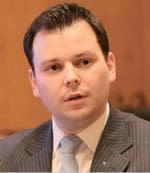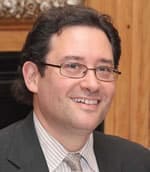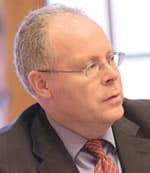TREASURY & CASH MANAGEMENT
Global Finance brings together some of the top figures in treasury management to discuss the influence that clients rapidly evolving needs are having on their business.

|
|
|
What are the chief global liquidity and cash management challenges facing the treasurer of a large corporate, and how can banks understand them better and assist their clients in addressing them?
JOSE FRANCO
, senior vice president, head of treasury and investment management, Europe, ABN AMRO: One challenge is the increasing globalizationin terms of suppliers, service centers, manufacturing and finance. Treasurers are seeking support in this globalization while retaining control of the firms cash flow. This is generally possible using the correct tools; however, this remains dependent on the sophistication and span of influence across multiple areas of the firm by the treasurer. Can our clients honestly say they can achieve a true, global liquidity solution? Or do they need a regional or local approach? Clients will need to create an efficient and flexible model that utilizes a local bank and then centralize these operating positions with an overlay bank. Once in place, the firm can align the globalization activities with the financial infrastructure. One additional challenge is that treasurers are under constant pressure to reduce costs while increasing their strategic roletax, cash forecasting, payments, receivables, supply chain.
ALAN VERSCHOYLE-KING
, managing director, head of global payment & trade services, Europe, The Bank of New York: The one thing thats really changed in the past 10 years is that the role of treasurer used to be almost a byproduct of the front-office business. The business had the control. That control has migrated somewhat into the treasury, so treasury has become a management event in its own right. The challenge in that is to understand, more or less in real time, what is happening in the businessto move from a multi-country approach to a regional approach and, ultimately, to a global approach. That migration has begun, but we as banksand the corporates themselvesneed to do more. We need to take the final step and gather that information in one place, to have it more or less real time and to manage it on a global basis.
GARY E. GREENWALD
, managing director, global head of capabilities and information products, Citi: One of the things banks have done over the past few years is to make a much more disciplined attempt to understand what is really driving our clients, what are their pain points, what are their strategies. A cash and treasury management solution has to be based on a clear perception of the clients needs. Treasurers are focused on the control and visibility of their liquidity and bank accounts and on moving to much more of a straight-through processing environment. This means they are also very conscious of the technology. They dont want to become technologists, but theres so much going on out there that many feel they really need to understand and be advised on how the pieces come together. It was taken for granted in the old days that, whatever you wanted to do, we fitted the pieces together. Now people are thinking much more strategically about the technology platforms.
FRANCO
: It comes down to flexibility. Each customers treasury drivers and structure are unique. Our customers are not the same everywhere around the world so we, as a bank, are obliged to give them a flexible solution to meet their unique local, regional and global needs. The only way were going to do that is to get to know and understand their business thoroughly. We have to be a specialist in their business. We need to know the ins and outs of what keeps them up at night, and only then can we really assist them in implementing effective solutions.
KING
: Theres also industry specialization. The challenges that treasurers face vary by industry, so their banks need to adopt an industry-based approach. Thats enormously beneficial to clients because the challenges that treasurers face, industry by industry, can be dramatically different.
GF
: Tell us about the changes in operating models and their impact on clients.
KING
: You could look at this question both ways: changes in operating models from clients, in terms of their buying behavior; and from banks, in the ways in which they manage and sell to their clients. Banks are seeing dramatic changes in the ways clients structure themselves. For example, the changes our institutional clients are making to their models can mean that the people we are talking with, and who are buying from us, can change dramatically. We might start off with the operations manager, then migrate through a CFO or COO, then end up with a network manager. The network managers function has changed much more into a true relationship management function, and we see that as our primary contact in many, many more situations.
GREENWALD
: The biggest trend Ive seen has been the consolidation of banking relationships. The number of corporate or cash management banks that a large multinational uses has shrunk to maybe a half or a third of what it used to be. There are two major themes driving that. One is the shared service centers, payments factories and regional treasuries: Its natural that there should be fewer providers talking to and servicing those more consolidated operations within a company. The other is the realization that every bank relationship a company has represents overhead. You have to put time into it. You have to invest energy. Treasurers are deciding on an optimal number of banks thats fewer than it used to be. For the bank thats a good thing. The more we can do with a large corporate, the more value we can provide because we understand them better. The flipside is theres more concentration of risk. So, while knowing a corporate better is important, so is raising the bar on quality and the ability to execute.
|
JOSE FRANCO |
|
Jose Franco serves as a corporate director and tcm_roundtable02
 Europe region head of global treasury and investment management, transaction banking, at ABN AMRO. Franco directs product management, advisory sales, strategy and solutions development in liquidity management and investment services for the bank’s European-based clients.
Franco developed most of his 10-year career with two of the most well-known names in the financial services industry. Prior to ABN AMRO he worked for Citi, where he held positions in private banking in Madrid and cash management sales and product management in London.
Franco holds a BA honors in international business from Universidad Nebrija in Madrid. |
FRANCO
: Things like Sarbanes-Oxley are having an impact on this, too. Our clients are keen to work with fewer banks because that reduces the risks. Following from that, our focus must be to ensure we can meet all our clients demands. That comes back to flexibility, being able to deliver. With Sarbanes-Oxley we can no longer say, Its got nothing to do with me. The good thing is this compliance also leads to best practices. A lot of corporates outside of the US, where they are required to comply, are ensuring they have a complete control process in place in all their markets, whether Sarbanes-Oxley applies or not.
GREENWALD
: The importance of control and control processes is showing up in all our clients globally. Years ago, people accepted a bank was a regulated institution. Now people want to see that an audit firm has looked at your management and your database controls and so on and issued an SAS70.
KING
: Clients also want to touch and feel your infrastructure. They want to see how your contingency processing works, your risk management controls. Weve seen enough examples now in corporates and in banks where the controls have been lax, so, on balance, its a good thing.
GF
: Connectivity and the way clients interact with their banks is a critical topic. What should we know about this?
GREENWALD
: A few years ago our clients began to ask us for a much more straight-through processing paradigm so we could connect direct into their ERP systems. It started with the largest corporates and the early adopters of true enterprise ERP systems and is moving down-market as the cost of ownership and cost of implementation come down. Banks are being asked to connect to their clients in much different ways. We can no longer dictate the standards; we have to say, Tell us what you have, and well figure out a way to get it into the bank.
KING
: Particularly the larger corporates are migrating to this quasi bank-to-bank model. First they want us to plug directly into their ERP system; then they want us to handle their back-office activities. That changes the nature of the game, because you end up focusing much more on, say, the information captured in the fields of the payment messages, which, traditionally, is not where you would have been with your corporate client. Its a very different game, and it presents challenges for us all.
FRANCO
: Treasurers are at different levels of sophistication with respect to their technology demands. Demands have rapidly evolved from supporting local and regional needs to providing consistency to global control. Over the next three to five years, we will rapidly progress to a place where corporates require hands-on 24/7 operating models with their banks.
GF
: We see a convergence of technologyERP, treasury tools, bank tools and so forth. Where is this all headed?
|
GARY E. GREENWALD |
|
Gary Greenwald heads global capabilities and
 information products for global transaction services cash management at Citi. The global cash management business is the most fundamental corporate product and one in which Citi has earned top-rankings internationally. Greenwald is responsible for treasury-related products such as TreasuryVision and outsourcing, for electronic banking products and for integration solutions. He is also currently working on bringing a new set of products to market, including digital identity management and white-labeled electronic banking. Greenwald joined Citi in 1983 and has held a number of diverse positions in both corporate and consumer banking. He holds a BS in economics from the University of Pennsylvanias Wharton School and an MS in statistics and operations research from New York Universitys Stern School of Business. |
GREENWALD
: You could envision a day not too far from now where banks might not even have Internet banking sitesor may have them only for the SME-type market. Our clients will be requesting us to take nuggets of functionalitybuilding blocksand perhaps plug into their treasury intranet or to their ERP system. Well see an unbundling of bank websites and more cash management functions performed through universal interfaces. One day all those processes that rely on proprietary technology from the banks might be carried out by a single tool. Were going to move to a much more service-oriented architecture and develop much more open standards.
KING
: If we all accept thats the way the industry is going, what then become the differentiators? The differentiation is your understanding of your client, his objectives, his needs, his challenges. The value from an advisory point of view is to help him extract the information he needs to address his challenges head-on.
GF
: Identity management has been a cash management necessity, and at times an impediment, since the beginning. What new developments should we know about in this area?
GREENWALD
: The banks have moved on authentication, prodded by various regulatory entities. The days of simple IDs and passwords are over. The more interesting part, though, is the ability of identity management and digital identities to take paper out of cash management processes. When we asked, Whats the pain point in banking? every client I spoke to said the process of bank account signatories or bank mandates, which even today is a paper process. If you happen to be the signatory on 100 accounts at 10 banks and move to a new role, and someone else comes in to that corporate role, that involves 100 pieces of paper, 100 copies of various corporate resolutions and articles of incorporation. You would think this should be as simple as a global search interface: Hit OK, and it changes. The reason its not is because theres a difference between the OK button on a computer and a true digital signature that can stand up in court.
KING
: Were working with clients on these issues and finding that there are some relatively small specialist organizations in areas like identity management that can support us as a major global bank. This is one of the areas where small entrepreneurial organizations can be really quite innovative in their thinking and in the products they develop. They can teach us a thing or two as we work through it with them.
FRANCO
: Technology is very much driving what our clients are looking for. One of the key areas for this in the future is biometrics. However, banks need to ensure that the technology offered is widely supported also by our clients. Many technology companies are coming up with innovative solutions around this, but banks are not technology companies; hence working in partnership is key to ensuring future needs are met.
GF
: Were seeing systems, operating models and such, designed for corporate giants, flowing to mid-market companies. How and why is this happening?
|
ALAN VERSCHOYLE-KING |
|
Alan Verschoyle-King is managing director, head of
 global payment & trade services, Europe at The Bank of New York. He joined The Bank of New York, London, in the role of managing director, head of global payment & trade services, Europe, in March 2006. He is responsible for the banks cash management and trade finance activities across the European region, where the bank has a successful footprint and strong growth plans. King began his career with Citi in 1985, where he held various positions in relationship management and transaction banking in London, New York and Frankfurt. In 1995 he moved to Barclays Bank in London, where he held senior management positions within global transaction banking. In 1998 he joined Bank of America in London as head of global treasury services, EMEA, before moving to ABN AMRO in 2000 as head of working capital, EMEA. He holds an honors law degree and a postgraduate diploma in legal practice from the University of Edinburgh, Scotland. |
KING
: Its a push and a pull. The pull side of it is that middle-market corporates typically are very aspirational. They monitor large corporates. They want to learn from them and apply the operating models and the infrastructures they have in place to support them. Theres a push on the bank side, because were in a scale business. We spend a lot of money developing solutions, and were very keen to take the core elements of those and offer them to the next tier down. Were driving them down-market.
FRANCO
: Mid-market today is potentially large corporate tomorrow. These companies watch what the large corporates are doing, and they adopt these best practices. They are looking at cutting-edge solutions and in some areas are now driving a lot of the innovation in liquidity management. Their goal is to try to do it more quickly, more efficiently and more simply. They can try different ideas because of their smaller scale and increased flexibility. Implementation is much simpler, yet the financial impact material.
GREENWALD
: One of the challengesand opportunitiesis taking innovations that typically start at the large corporate level and making them work as you move slightly smaller. They want the same end result but may not have all the resources to make that happen. For example, everyone wants to concentrate excess cash and earn a return on it. Smaller companies may need an automated sweep-and-invest type product to do that, and our challenge is taking the solutions weve created for the large corporations and modifying them to work pragmatically with smaller companies.
GF
: What effect is the delay in guidance from the EU concerning SEPA [single euro payments area] having?
FRANCO
: The biggest challenge for corporates will be to understand the impact of SEPA and the benefit to their business/treasury model. At the moment, the uncertainty comes from the various messages received from banks, regulators, etc. Many treasurers link SEPA to a desire to manage everything from one account. But its really not clear whether they are ready yet to go down to a one-account model; this requires not only a strong SEPA market infrastructure but highly advanced ERP systems within the firm.
GREENWALD
: Its not been so much a delay in guidance from the EU; its pretty clear what that mechanism is and how it clears and what the payment types are. Its more a matter of the banks being ready and of corporates taking time to adopt. Well see the early adopter clients testing the waters perhaps, but its very much a model of listen, watch, evolve, put a toe in the water.
KING
: Im still a skeptic about who is driving SEPA and why. It seems more an industry infrastructure event than something that clients are demanding. The banks will be there ready to do what they need to do, but the vast majority of clients havent yet figured out how this is really going to add value. We dont have many clients asking us how were going to add that value to them. It tends to be the other way around: We go to clients and tell them how we can add value to their infrastructure. Im still slightly skeptical about how quickly it will add value.
GF
: Supply-chain financing seems to be migrating closer to the cash management function. What are the emerging models for this and the value propositions being offered?
KING
: Concepts weve been discussing for a while, such as integration of the financial and physical supply chains, are actually beginning to happen. Its being driven by clients who are asking us to bring it all togetherthe paper flow, the dialogue with their clients, the financial infrastructurein such a way that they dont lose control over the whole supply chain, physical and financial, in relationship with the developers. The opportunities to streamline the infrastructure and reduce costs and deliver new solutions are very exciting.
FRANCO
: This is one of those areas where we can be extremely inventive with our clients in how we support them and how we help them and their whole business model. To do so, though, we have to be industry specialists and know it inside out. When you look at the number of different touch points we have nowadays with our clients, banks really have to understand the underlying flows within their clients organizations.
GREENWALD
: Many of us have found it a little strange that while the physical palette of goods can move in a day from supplier to manufacturer, the financial supply chains element lags days or weeks behind. So everyones looking at this much more holistically and organically. Weve matured in both the frameworks by which we think about it and the places where banks can find areas to add value in any of those stages. As banks, were working to get the stickiness out of the process. Theres a huge opportunity on providing liquidity in the supplier and distributor financing side, and I think there are some innovations to come in that space.
FRANCO
: The beautiful thing is, its win, win, win: win for the buyer, win for the supplier, win for the bank.
GREENWALD
: This is a wonderful space where you have built-in metrics. There are built-in ways for a company to see progress against benchmarks, against peers, as they get more efficient in some of these cash conversion cycle opportunities.
KING
: The whole development also forces you to figure out where you can play and not play. Weve been presented with a number of scenarios by clients recently where very quickly we realized that as an organization we were not going to be able or willing to play across that range of activities. Because its a greater concentration of risk than we would be willing to accept. So we found a partner who was willing to play in particular areas, and together we created a solution that added value.

|
|
|
GF
: Cultural differences can have a significant impact on the implementation of treasury solutions. Do you agree? If so, how are these dealt with?
FRANCO
: This is double-sided. Cultural differences have affected and will affect in the future the way treasury organizations adapt and globalize and so forth. But today the treasury office has few boundaries: You can quite easily be speaking to a treasurer who was last year working in the Asian office and this year is in the United States.
GREENWALD
: Its less a national/cultural difference per se: The culture of large global corporations we work with has a big impact on how we work together. It also shows in how companies deal with their vendors. Do they deal with them as partners? Or do they deal with them at arms length? Is it driven by procurement? Is it driven by treasury? More so than any national culture, the biggest differences are in how companies operate and how their mindsets are.
KING
: In after-sales activity you really see cultural differences. Once your solution is up and running and youre dealing with a client on a day-to-day basis, thats where cultural differencesgeographic, national and industryreally come in. In some ways, thats even more of a challenge to manage.
Joseph Giarraputo



